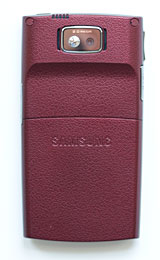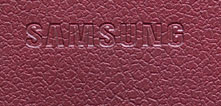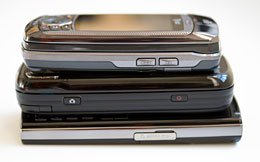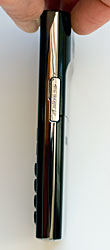
|
|||||||||||||
We weren't alone in our complaint that the BlackJack's d-pad was too flat, and Samsung heard us: the BJ II's d-pad has raised edges. Not only that, but it spins to navigate through icons and such as well as working like a "normal" d-pad. The call send and end buttons are large which we like, and there's a back button and home button just below the display. The phone feels great in the hand, and is more easily operated with one hand than the wider Moto Q9. The phone's sides top and bottom have a chrome trim ring (we'd have preferred something more grippy), and the microSD card slot lives under a door in the trim on the phone's right side. The volume up/down keys and combined proprietary sync/charge/headset port are on the left side and the camera lens is on the back where there's a subtle hump that helps keep the phone in hand. The loudspeaker grille is on the top edge toward the rear and the battery is under a door on the back along with the SIM card slot. The phone fits fairly easily in a pocket since it's so slim and it isn't as wide as the Motorola Q9 Global making for a more comfortable fit in the hand and pocket.
Phone Features, Reception and Data The original BlackJack was an RF king on 3G; it had great reception. The BlackJack II loses the "king" title and merely has good to very good reception. Where the BlackJack got 4 bars, the BlackJack II gets 2 to 3 bars, and where the BlackJack held firmly onto two bars of 3G, the BlackJack II sometimes switches back and forth between 3G and EDGE. GSM and EDGE are equal on the two BlackJacks. For 3G, that means it will work in areas with strong coverage and areas of weaker coverage but watch out if you live or work near that cellular near-black hole-- the BJ II will fall in. The BlackJack II falls behind the original BlackJack, Motorola Q9 Global or the Pantech Duo. We check actual 3G reception in db rather than relying on bars (enter *#0011# to see detailed reception info on the BlackJack and BlackJack II) and saw an average of -93 db on the BlackJack II vs. -85 on the Nokia N95-3 (lower numbers are better) in a strong coverage area.
Voice quality is very good and reasonably loud, and the rear-firing loudspeaker is clear and moderately loud (as loud as the Pantech Duo but with less buzzing on the loudest setting, but not as loud as the megaphone Moto Q9). Voice quality through the Bluetooth headsets we tested was good and volume was a hair quieter than average. We tested the BJII with the Samsung WEP-200, Cardo S-800, Samsung SBH500 stereo Bluetooth headset and the Plantronics Pulsar 590 stereo Bluetooth headset. Like the original BlackJack, the BJII sets the most recently paired headset as the default headset. Despite this, it reconnected to the first paired headset automatically for calls with no trouble when the most recently paired headset was powered off. But we did notice a quirk with the stereo headset: even though the BJII connected to it as a handsfree headset, the phone didn't route stereo out (A2DP) through Windows Media Player Mobile until we went into the Bluetooth headset settings and re-enabled the stereo headset profile. Stereo sound was among the best A2DP phones we've tested (and that's a lot). The Samsung SBH500 sounded particularly good, and rivaled wired headphones. The BlackJack II supports speed dial and caller ID but doesn't come with voice command or voice dialing software. Microsoft Voice Command 1.6 (available for purchase for ~ $30 from sites such as Handango) works fine with the BlackJack II and supports voice dialing over Bluetooth (press and hold the call key on the headset to start Voice Command). We couldn't find a way to start Voice Command directly from the phone itself however. Data transfer speeds on HSPDA were very good in our DSL Reports mobile speed test, with an average of 875 kbit/sec with 3 out of 4 bars of 3G reception. Web pages load relatively quickly, including non-mobile optimized sites with dense content. Standard for Windows Mobile 6 are Internet Explorer Mobile and the mobile version of Outlook, whose email/SMS/MMS component is called Messaging. IE does a reasonable job of rendering HTML web sites, though we recommend checking out the new, free Opera Mini 4 as well. Messaging handles POP3 and IMAP email along with MS Exchange and push email if your company runs Exchange 2003 SP1 or newer. The BlackJack II also works with AT&T's Xpress Mail service and they promise Good push email support in the future. The smartphone can be used as a high speed wireless modem for a notebook over Bluetooth using the PAN profile (AT&T charges extra for tethering). Horsepower and Performance The BlackJack II's 260MHz Texas Instruments OMAP1710 processor offers a good balance between performance and power consumption. The smartphone has a bit more pep than the once ubiquitous 200MHz TI OMAP Windows Mobile smartphones, and there's little lag when opening the Start Menu and launching applications (by Windows Mobile standards where there's always some lag). The Motorola Q9 Global feels a tad speedier thanks to its 312MHz processor and the Pantech Duo is the fastest thanks to its 416MHz processor (smartphones don't usually have 400MHz+ processors, rather their Pocket PC big brothers often do). Samsung generously upped the memory and the BJII has 128 megs of RAM (used like RAM in your computer to run applications) with ~ 87 megs free at boot. While running out of memory isn't uncommon among Windows Mobile devices because applications continue to run in the background when you close them, we can't imagine running out of memory on the BJII with average use. 256 megs of flash memory for storage also mean plenty of room to install applications. There are approximately 140 megs free, and if you need more for movies, music and etc. the BlackJack II has a microSD card slot that accepts standard and SDHC high capacity cards. Multimedia and Camera Like most AT&T 3G phones, the BlackJack II comes with CV (Cellular Video, formerly known as Cingular Video). This streaming video service offers a selection of free content (a data plan is required however) and pay-for content for HBO TV show episodes. The current HBO lineup includes The Wire, Inside the NFL, Curb Your Enthusiasm and Extras and costs $4.99/month billed to your wireless bill. Episodes are broken up into approximately 5 minute segments, so a half hour show is comprised of 5 segments. Free content includes CNN, ESPN, The Weather Channel, Comedy Central and Fox Sports. Content plays through Windows Media Player Mobile and is streamed at less than the BJII's QVGA resolution. You can use Media Player's full screen option to stretch the video to play full-screen, though it looks less sharp. Voice and video stayed reasonably in sync unless we stretched to full screen view and the quality is as good if not better than Verizon's V Cast video.
For music and video playback of non-streaming content, Windows Media Player Mobile 10 handles MP3, WMA, WMV and ASF files. Performance was average among MS Smartphones when playing our 330kbps test movie, which means some frame drops and jerky playback. Pocket PC phones with their faster CPUs and sometimes dedicated graphics chips are generally better suited to playback of burned video content. The BlackJack II's 2.0 megapixel camera takes decent shots with good sharpness and reasonably accurate color balance. To launch the camera, briefly press the camera key on the keyboard, but don't press and hold it for a few seconds as this instead activates the smartphone's screen zoom feature. Image maximum resolution is 1600 x 1200 and max video resolution is QVGA 320 x 240. The camera uses the entire screen as the viewfinder, with small icons up top that appear briefly to inform you of current settings. Press the right softkey to bring up the menu, which annoyingly times out and closes itself in a just a second or two (be fast with your selections). Here you can change resolution, select a custom white balance, use the self-timer, set default save location, set the shutter sound (there is no "off" option) and more. There are two video options- 176 x 144 short duration for MMS and unlimited duration at up to QVGA resolution. Video quality is passable at the highest resolution setting and is recorded at 15fps in QuickTime-friendly format.
Battery Life Gone are the standard and extended batteries packaged with the original BlackJack and several other Samsung PDA and smartphones over the years. Samsung opted for a single 1700 mAh battery and somehow managed to keep the phone quite slim. That's a good deal of power for a standard battery and we found the BJII easily lasted two days on a charge with moderate use compared to 1 to 1.5 days with the slim battery on the original BJ. Streaming an hour's worth of CV with MS Direct Push email running all day long will reduce battery life and as phones become more capable, it becomes difficult to describe an "average" usage pattern but under most circumstances the BJII does well. Samsung claims an impressive 7 hours of talk time, and we managed over 5 hours on 3G (GSM talk time will likely be longer). GPS The internal GPS works with TeleNav Navigator ($9.99/month or $99/year) and with 3rd party GPS programs if you're allergic to subscription services. Basic TeleNav Maps (mapping with no GPS use) is free. Though we found TeleNav to be fast, accurate with very good voice guidance, traffic information updates and routing. One benefit of the subscription based service is updates and new map data are sent to the phone when available. No need to buy an upgrade or load new maps from a CD. We tested the GPS with Google Maps and Windows Live, both of which worked fine with the GPS. The GPS is not "locked" and does work with other GPS programs such as Google Maps-- just be sure to choose "GPS Intermediate Driver" rather than a COM port. If you use a GPS program that requires a COM port rather than the Windows Mobile managed COM port (that's what the GPS Intermediate Driver reallly is), then you will need to use hacks such as those found on Modaco.com to assign the GPS to COM4. The GPS isn't the strongest, and had to go outside under open skies (or in the car) to acquire satellites, but once we did, it managed to hold onto a signal and get us reliably from point A to point B in the Dallas Metroplex. Update April 2008: Interestingly, we received black and red BlackJack II models in April 2008 that had stronger GPS performance with faster satellite acquisition times and they could even get a fix within 6 feet of a window indoors. Software In addition to the standard Windows Mobile 6 Standard application suite which includes mobile versions of IE, Outlook, Windows Media Player and MS Office (with read/ edit-only versions of Word, Excel and PowerPoint), Samsung and AT&T include a few handy utilities including a Java VM, PDF viewer, an RSS reader, Task Manager, Syncdata's Smart Search, and an IM client that handles AIM, Windows Live Messenger and Yahoo IM services. AT&T includes their usual XPress Mail, AT&T Mall, XM Radio (requires a monthly fee), MusicID and AT&T Music (Napster). MobiTV is pre-installed (a streaming TV service that that requires a monthly fee). Though the Office Mobile apps nominally can't create new documents (just view and edit them), it's easy to create new documents: just keep a blank document on the device and open it to edit it and save it as a new document. Conclusion A welcome, though not earthshattering upgrade to the BlackJack. As the adage goes, if it ain't broke, don't fix it; and the original BlackJack was an extremely popular phone thanks to its low price, slim design and power. The II adds features that keep the BlackJack competitive in 2008: GPS, Windows Mobile 6, 2MP camera, more memory and a single slim high capacity battery. The phone appeals both to business power users and heavy texters thanks to its QWERTY keyboard and relatively low price, but it has the features power users crave (minus WiFi). Whether you choose the BlackJack II, Moto Q9 Global or Pantech Duo, you won't go wrong. AT&T's MS Smartphone lineup is impressive and the BlackJack II is one of the most pocketable phones with a front-facing QWERTY keyboard on the market. Pro: Full-featured and the price is right at $99 after rebates. Super-slim and quite pocketable. Attractive looking and reasonably solid. GPS is handy for those who hit the road and the camera is actually decent, unlike the original BlackJack's. Plenty of memory to run programs and store data. Supports SDHC high capacity microSD cards. AT&T has strong service nationally and 3G HSDPA makes for fast downloads and page rendering. Con: Slippery! Proprietary Samsung connector for sync/charge/headset. GPS is slow on initial satellite acquisition. Voice dialing software not included.
Web sites: wireless.att.com, www.samsung.com Price: $99 after rebates with 2 year contract
| |||||||||||||










